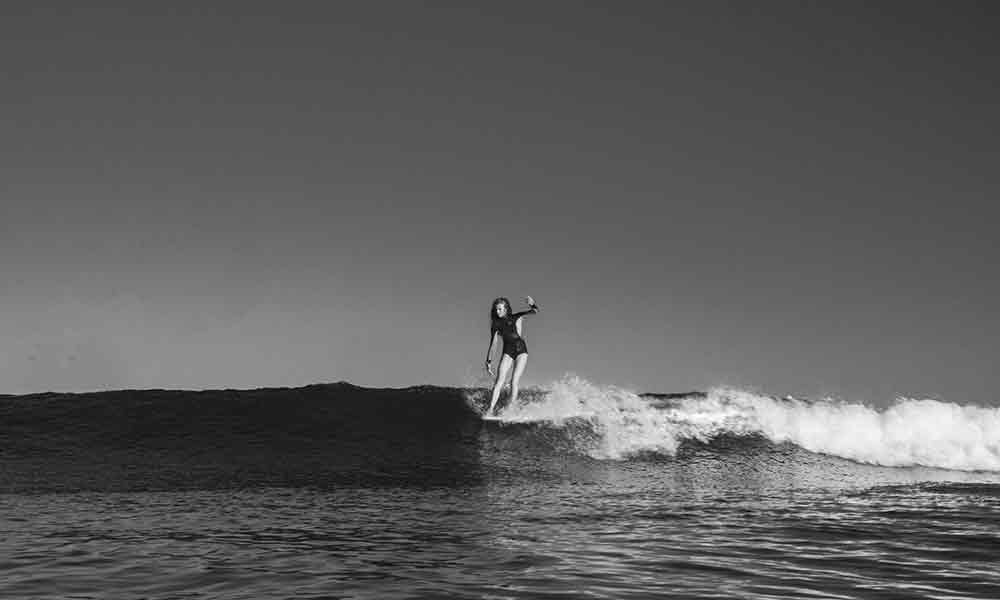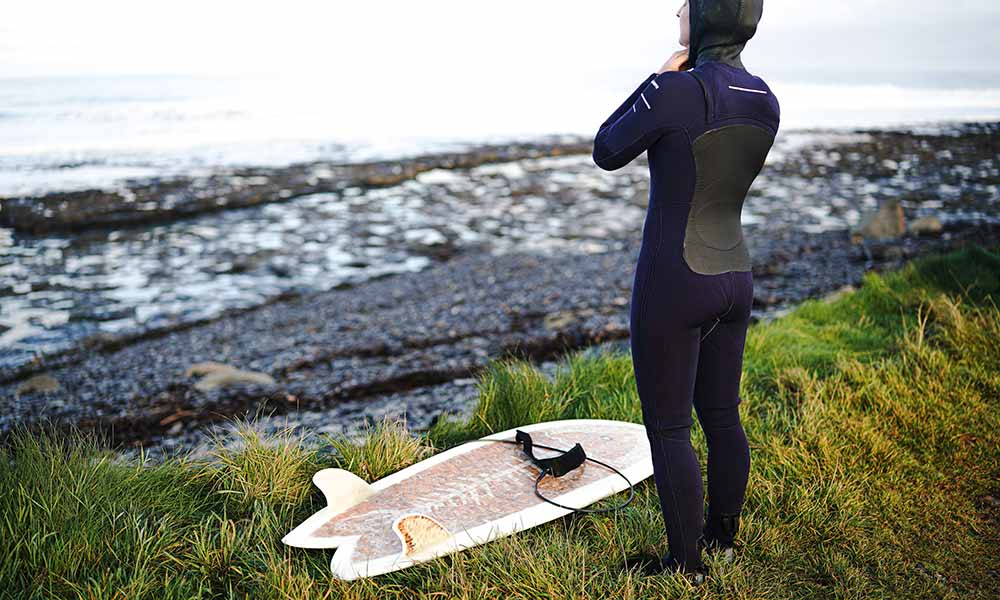Hang ten is a phrase you’ll hear a lot in surfing. But what does it mean, why do people say it, and how can you do it?
The term “hang ten” refers to a longboard surfing maneuver whereby a surfer leaves all ten toes hanging over the nose of the longboard surfboard as they surf the wave
From nose riding and drop-knee riding to hang 10, there are a few cool moves that you can perform on a longboard surfboard. Some of these are tricky, others can be tackled by beginners.
How to Perform a Hang Ten Surfing Maneuver
To perform the move, you first need to balance your surfboard in the wave, ensuring that the tail is just underneath the water.
That will allow you to walk to the front of the board, at which point you can hang all ten toes over the nose.
Once your toes are touching the nose of the board, make sure you throw a little hang ten/hang loose sign to your fellow surfers.
How Tough Is It To Have Ten Toes Hanging On A Surfboard?
Hang ten is one of the best-known surfing moves, but it’s also one of the most difficult to perform.
You need a little experience and good control of your board before you should consider trying a hang ten.
Unless you’re persistent, of course, because if you keep trying, you’ll get there eventually, albeit with a lot of wipeouts.
Where Else Is The Phrase Hang Ten Used?
The phrase “hang ten” has also been used in contexts outside of surfing, although it’s nowhere near as common. In skateboarding, for instance, it’s the name of a nose manual trick that was created in honor of the surfing maneuver.
Hanging Five on A Longboard Surfboard
The hang five is the lesser-known sibling of the hang ten. It is performed by hanging a single foot over the nose of the surfboard, thereby hanging “five” toes as opposed to ten.
How to Hang Five on a Longboard Surfboard
To perform a hang five, it’s best to wait until you’re in the top half of the wave, as that will keep you level and give you more control when performing this maneuver.
Place a little weight on the back of the board to stall it and lift the nose in the air. Keep your weight toward the wave-side of the board and then cross step or slide toward the nose. Slip one foot onto the edge of the board and hang your toes over the edge.
It’s best to use your non-dominant foot for this, keeping your back foot behind you. So, if you’re a regular rider, your back foot will be your right foot while your “hang five” foot will be your left.
You’ll need to shift your weight between your two feet to maintain your balance and prevent a nose dive.
The Cheater Five
The cheater five was popularized by Paul Strauch. It is performed by crouching and extending your non-dominant leg to the nose while keeping your weight on your rear foot.
Extend your left leg (assumes you are a you a regular-foot surfer) until your toes reach the edge and then hang them over.
Nose Riding
Nose riding or “noseriding” is synonymous with the hanging ten on a longboard surfboard, as it requires you to surf the front end of the surfboard, putting you in position to perform the hang ten or hang five.
You can perform a nose ride by staying on the upper third of the wave, keeping your board stable, and then walking/cross stepping toward the nose.
Once there, you just need to keep your balance.
Nose riding may feel a little strange at first, but it’s something that you will get used to. And the more you do it, the easier it will become. Eventually, you’ll get a feel for nose riding and will know exactly when and how to do it.
If you’re using a nose ride to perform a hang ten, stick with the hang five first and take it easy. Once you have mastered the hang five, you can move onto the hang ten.
The History of Noseriding
Nose riding is said to have been popularized during the 1950s, during which time it was common to have fins installed on longboards. Surf fins helped to anchor the tail of the board to the water, giving the rider more freedom and allowing them to edge toward the front of the board without nose diving.
The hang five/ten became popular during this time and began appearing in surfing magazines. It’s a trick that became synonymous with top surfers of the late-50s and ’60s, including Phil Edwards, Joe Quigg, Dewey Weber, and Bob Purvey.
At the same time, designers were creating boards that would hold up better while nose riding, allowing this technique to be performed by riders of all sizes, weights, and skill levels.
In 1965, Tom Morey, who would later become known as the inventor of the bodyboard/boogie board, created the first pro surf contest based around nose riding, defined as riding the final quarter of the board.
Drop-Knee Turning On A LongBoard Surfboard
Drop-knee turning is when you turn a longboard by dropping the read knee closer to the deck of the longboard surfboard.
How to Do a Drop-Knee Turn
To perform a drop-knee turn, you need to literally drop your knee on your back foot, bringing it near to the deck.
Place your foot on the side of the board that you wish to turn and apply pressure. That will lean the longboard surfboard in the right direction, at which point you can use your arms to follow the natural flow of the turn and keep your balance.
Cross Stepping On A Longboard Surfboard
A cross step is when you move your body forward and backward on your longboard surfboard. It will take you from the back of the board to the front, and while it might feel a bit awkward at first, you’ll be moving freely in no time.
The trick is to follow through with the technique and to resist the temptation to shuffle or rush.
How to Do a Cross Step on a Longboard
A properly performed cross step is like a dance—a one-person waltz or tango.
When performing a cross step, move slowly and methodically while keeping your balance centered.
Keep your knees slightly bent and slowly bring your back foot over your front foot. Repeat this process as you move from the back of the board to the front.
Don’t point your toes straight ahead and when you reach the nose, simply reverse, repeat, and start cross stepping back toward the tail.
The Fade
A fade is a fundamental technique that all longboard surfers should learn. It helps the rider tap into the energy of the surf and tackle smaller waves.
How To Fade On A Longboard Surfboard
A fade occurs when a surfer paddles into a wave and pops up in the opposite direction that they want to surf, such as paddling left to go right.
It’s a good technique to learn when you’re dealing with smaller waves and want to maximize your surf session.
To fade, simply paddle into a wave, pop up, and then switch to focus on the opposite direction. Once you switch your focus then the board will follow.
The Turtle Roll
Also known as the Eskimo roll, the turtle roll will help you to navigate big waves that you can’t simply punch through. It’s an important technique to learn when you’re riding longboards and foamies. They have a lot of buoyancy and this can make it difficult to duck dive under the water and wait for the wave to pass.
The turtle roll is performed by dropping to a prone position, wrapping your arms around the board, and then pulling it over you, effectively using it as a shield for when the wave breaks.
How to Turtle Roll on a Longboard Surfboard
To perform a turtle roll, simply follow these steps:
- Place your surfboard so that it is perpendicular to the oncoming wave and stop paddling.
- Hold onto the rails of the board, bend your elbows ever-so-slightly, and force the nose underneath the water.
- Refrain from wrapping your legs around the board. Only use your arms.
- Push one knee against the board and brace yourself.
- Flip the board over and maintain a tight grip as it rolls.
- Wait for the wave to crash over the board.
- Flip back around, resume your position, and continue paddling.
You can practice the turtle roll in small waves, honing and fine-tuning your technique so you’re ready for when those big waves hit.







